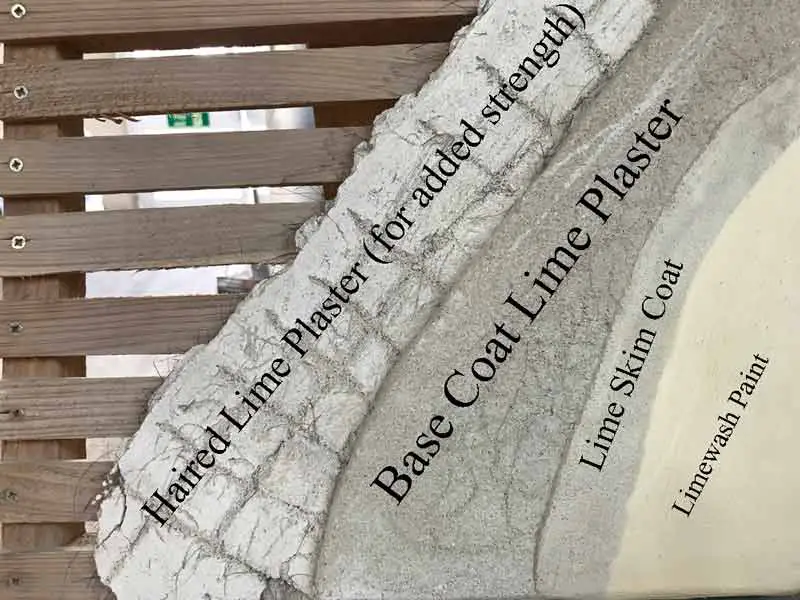
When working with lime-based materials, it’s important to consider the safety risks. Lime plasters, like all other lime-building materials, use lime as a binder. Lime is alkaline and caustic, so the correct safety measures must be taken. So, is lime plaster safe to use?
Lime plasters are safe to use. However, the health risks must be understood. Lime is caustic, which means it can cause burns if it comes into contact with your skin or eyes. As a general guideline, always wear good eye protection and gloves when working with lime. In addition, a dust mask should be worn when removing old lime plaster, mortar or render.
Let’s take a closer look at what lime plaster is, its health risks, how to protect yourself from those risks, and the advantages of using lime plasters.
A Brief Overview of Lime Plaster And its Uses
Lime plasters are among the oldest building materials, along with mud bricks and plaster. The ancient Egyptians used lime plaster inside temples and pyramids as a durable finish. These lime plasters are over 4000 years old and still intact and hard! Talk about durability!
Lime plasters are made by mixing a type of lime, either hydraulic or non-hydraulic (lime putty/fat lime), with various aggregates and water. Non-hydraulic plasters are the gold standard for lime plasters. They are more workable, breathable and flexible than hydraulic plasters. If you have the choice, non-hydraulic lime plasters are the way forward.
Good lime plasters can be applied to most substrates. They work best with rough or porous surfaces as they require a mechanical key (think of this as something for the plaster to hold onto) to stick to the wall or ceiling. Commonly, lime plasters are applied to laths. These are around 20mm wide strips of timber, with gaps that the mortar can cling onto. Below is an example of lath and plaster work.

Health and Safety Concerns With Lime Building Materials
There are several health risks to consider when using lime building materials, all with simple solutions to keep you safe. Let’s take a closer look at each risk factor and how to protect yourself.
Protecting Yourself From Lime Dust
Whether you are removing old lime plaster or mortar or cutting open a bag of fresh hydraulic lime, you must be careful around the dust. Lime dust from old plaster or while mixing new plaster can irritate your breathing passages. Possibly causing severe coughing and sneezing.
The good news is, it’s fairly easy to protect yourself from this dust. At your local lime specialist, they should supply the correct types of dust masks for working with lime. These should always be worn if mixing fresh mortar or removing old ones.
Related article: Is Old Lime Plaster Dust Harmful? Exploring the Health Risks
Protecting Yourself From Burns Caused by Lime
Lime is a caustic material. It is highly alkaline. This means it can burn and corrode organic material with a chemical reaction. The most dangerous type of lime is quicklime, also known as burnt lime. This lime is the most caustic and can cause severe burns to your skin, eyes and lungs.
Believe it or not, quicklime was actually used as a weapon by the Romans. In 80 BC, Roman general Quintus Sertorius distributed large clouds of choking quicklime. This tactic helped him defeat a Spanish tribe that had taken refuge in a cave! Surprisingly, there are quite a few accounts of lime being used as a weapon, so what’s the best way to protect yourself from it?
Again, a suitable dust mask should be worn. If you feel any burning sensation while breathing, the dust mask isn’t suitable, or unfiltered air is getting in. One benefit to quicklime dust is that you can feel it burning when you breathe it in, makings it easier to avoid.
Additionally, you should wear gloves and cover up as much skin as possible to reduce the chance of lime coming into contact. If you do get lime on you, get to the nearest tap or hosepipe and give it a good rinse off. If left, the lime will react with the moisture on your skin and begin slaking. Lime can reach temperatures of 150°C, so you don’t want this happening.
Always Wear Eye Protection While Working With Any Type of Lime
Because limes are alkaline, they can cause severe burns. In addition, quicklime can react with the moisture within your eyes. If you don’t treat this quickly enough, it can lead to blindness. But don’t worry; there are simple solutions to prevent this from happening.
You should always wear eye protection. Goggles are best as there is no way for the lime to get in around the glasses. If you get lime in your eye, get to the nearest tap or hosepipe. Have the water running over the affected eye for at least 20 minutes while rolling your eye around to ensure all of the lime is rinsed out. Do not use any chemicals to wash your eye, as they could cause a reaction with the lime.
It should be noted that if you are working somewhere with limited water available, it would be worth keeping some clean bottled water on hand. This could come in very handy if anyone were to get lime in their eyes.
Related article, Does Lime Plaster Contain Asbestos?

